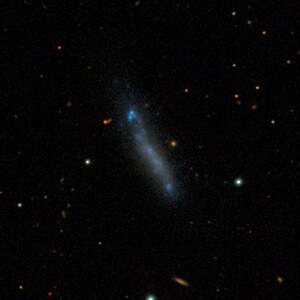IC 3105
| Galaxy IC 3105 |
|
|---|---|

|
|
| AladinLite | |
| Constellation | Virgin |
|
Position equinox : J2000.0 , epoch : J2000.0 |
|
| Right ascension | 12 h 17 m 33.7 s |
| declination | + 12 ° 23 ′ 17 ″ |
| Appearance | |
| Morphological type | In: / HII |
| Brightness (visual) | 14.1 mag |
| Brightness (B-band) | 14.6 mag |
| Angular expansion | 1.90 'x 0.6' |
| Position angle | 27 ° |
| Surface brightness | 14.1 mag / arcmin² |
| Physical data | |
| Affiliation | Virgo cluster (?) |
| Redshift | −0.000547 ± 0.000013 |
| Radial velocity | −164 ± 4 km / s |
|
Stroke distance v rad / H 0 |
(8 ± 1) x 10 6 ly (2.35 ± 0.37) Mpc |
| history | |
| discovery | Arnold Schwassmann |
| Discovery date | September 12, 1900 |
| Catalog names | |
| IC 3105 • UGC 7326 • PGC 39431 • CGCG 069-130 • MCG + 02-31-080 • KUG 1215 + 126 • VCC 432 • HIPASS J1217 + 12 • HOLM 360A • EVCC 282 | |
IC 3105 is an irregular galaxy with extensive star formation regions of the Hubble type Im in the constellation Virgo on the ecliptic . It is estimated to be 8 million light years from the Milky Way . Together with IC 3099 and IC 3100 it forms the Galaxientrio Holm 160 . It is listed as a member of the Virgo galaxy cluster under the catalog name VCC 432 .
The galaxies IC 3078 , IC 3081 , IC 3137 , IC 3138 are located in the same area of the sky .
The object was discovered on September 12, 1900 by the German astronomer Arnold Schwassmann .
